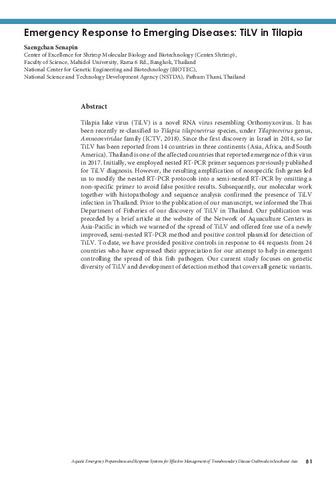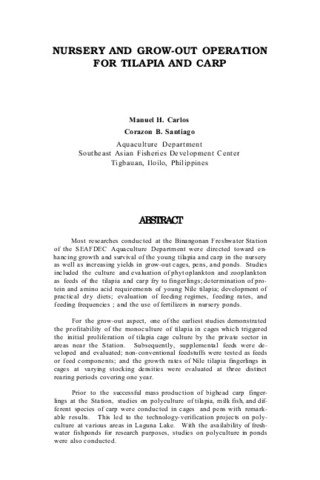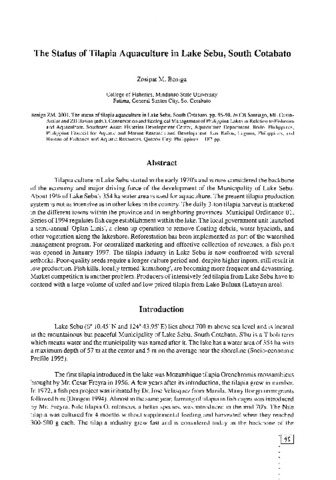Fatty acid composition of Nile tilapia Orechromis niloticus muscles: A comparative study with commercially important tropical freshwater fish in Philippines
- Global styles
- MLA
- Vancouver
- Elsevier - Harvard
- APA
- Help

Download URL
ag.arizona.edu日付
2008Page views
907ASFA keyword
AGROVOC keyword
Taxonomic term
Geographic names
Metadata
アイテムの詳細レコードを表示する
Share
抄録
Six tropical freshwater species were collected from Philippines in order to study the characteristic of polyunsaturated fatty acids distributions. 16:0 and 18: l n-9 were the predominant saturated fatty acid (SFA) and monounsaturated fatty acid (MUFA) in both neutral lipids (NL) and polar lipids (PL). There was an absence or very low values of n3 highly unsaturated fatty acid (HUFA) in NL of all species. However these fatty acids found in PL of all species studied with higher levels. The high proportions of docosahexaenoic acid (DHA) in PL were found with catfish Arius (20.71%), ayungin (17.64%), and snakehead (17.09%) whereas anabas (4.21%) gave lower DHA content. In PL, arachidonic acids (ARA) was found in high proportions, and also is superior to eicosapentaenoic acid (EPA) (ranged from 3.35 to 10.67% and from 0.42 to 4.74%, respectively). Tilapia lipid appears to be intermediate in nutritional quality between all species studied; the proportions of DHA, EPA and ARA in PL were 16.27%, 4.52% and 9.36%, respectively. According to the n-3/n-6 ratio in both fractions, only ayungin is in the range typical of freshwater fish. Our results indicate that the wild tropical freshwater fish studied here are not good sources of n-3 HUFA fatty acids. Therefore, aquatic nutritionists and farmers should combine their efforts in order to manipulate the nutritional quality of these species to enhance their n-3 HUFAs concentrations especially when these species are reared in captivity system. The wash-out strategy may provide an adequate description of the changes in the fillet lipid fatty acid profiles of fatty fish.
Keywords
Tropical freshwater fish Polar lipids Neutral lipids docosahexaenoic acid eicosapentaeoic acid Arachidonic acidType
Conference paperCollections
- Conference Proceedings [299]
Related items
Showing items related by title, author, creator and subject.
-
Emergency response to emerging diseases: TiLV in tilapia
Senapin, Saengchan (Aquaculture Department, Southeast Asian Fisheries Development Center, 2019)Tilapia lake virus (TiLV) is a novel RNA virus resembling Orthomyxovirus. It has been recently re-classified to Tilapia tilapinevirus species, under Tilapinevirus genus, Amnoonviridae family (ICTV, 2018). Since the first ... -
Nursery and grow-out operation for tilapia and carp
Carlos, Manuel H.; Santiago, Corazon B. (Aquaculture Department, Southeast Asian Fisheries Development Center, 1988)Most researches conducted at the Binangonan Freshwater Station of the SEAFDEC Aquaculture Department were directed toward enhancing growth and survival of the young tilapia and carp in the nursery as well as increasing ... -
The status of tilapia aquaculture in Lake Sebu, South Cotabato
Beniga, Zosipat M. (Aquaculture Department, Southeast Asian Fisheries Development Center; Philippine Council for Aquatic and Marine Research and Development (PCAMRD), Department of Science and Technology; Bureau of Fisheries and Aquatic Resources, 2001)Tilapia culture in Lake Sebu started in the early 1970's and is now considered the backbone of the economy and major driving force of the development of the Municipality of Lake Sebu. About 19% of Lake Sebu's 354 ha water ...







